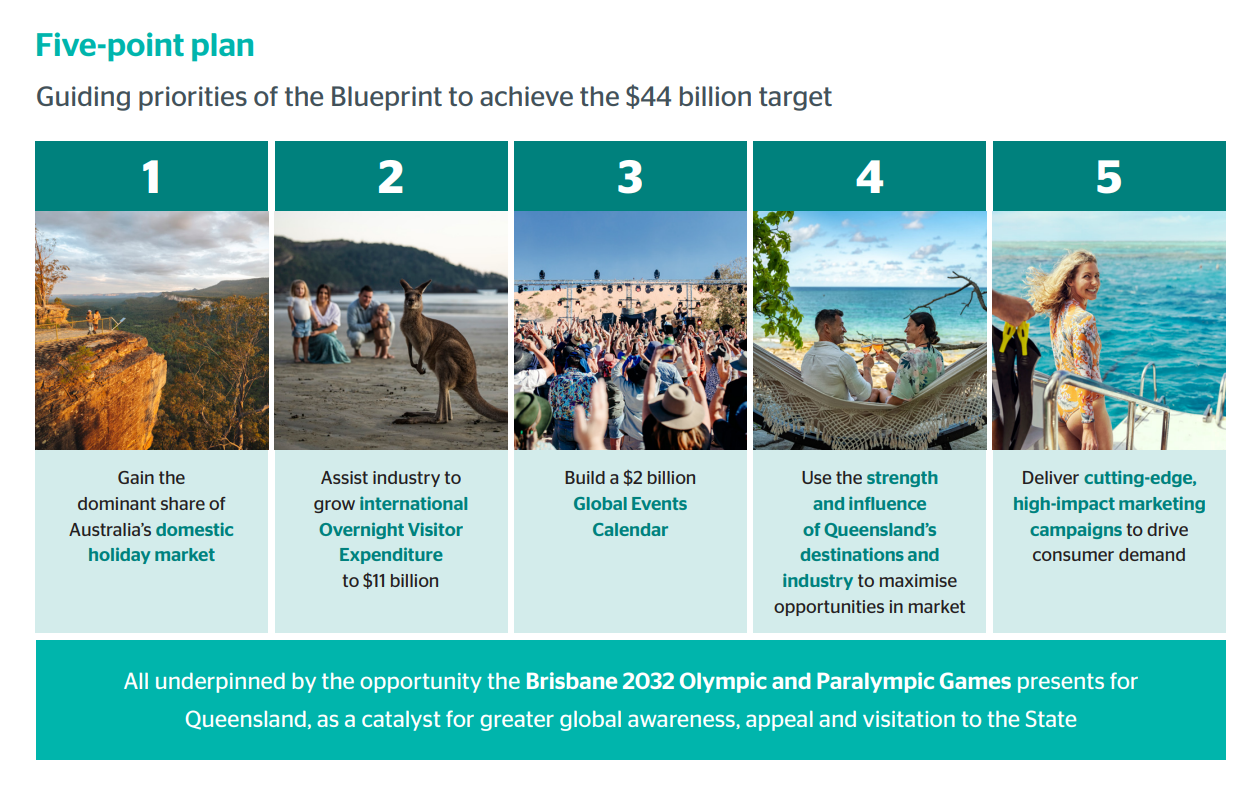
by fmadmin | Aug 9, 2024 | Content Marketing, Digital Marketing, Marketing Strategy
Discover how you can leverage Tourism and Events Queensland’s (TEQ) recently launched strategy: Towards Tourism 2032.
As the Olympic torch tracks its way to Brissy for the 2032 Games, how will you make the most of this exciting opportunity?
“In the case of the 2032 Games, it is possible we will see at least $17 billion of economic and social benefits for Australia, with around $8 billion of that flowing into Queensland.” Westpac Business Bank Chief Economist, Besa Deda,
Tourism and Events Queensland (TEQ) recently launched the TEQ Blueprint to support their Towards Tourism 2032 strategy. This Blueprint aims to position Queensland as the travellers’ destination of choice through bold and globally recognised marketing and events campaigns. These initiatives will drive our Queensland tourism industry towards its goal of a $44 billion-a-year visitor economy.
So, how can you maximise your marketing strategy to leverage these initiatives and benefit from this amazing opportunity?

TEQ’s Five-point plan to guide their Towards Tourism 2032 strategy. Image credit: The TEQ Blueprint
The opportunity for businesses
Businesses have numerous opportunities to capitalise on TEQ’s Blueprint leading up to the Brisbane 2032 Olympics. As the government drives significant investment and strategic campaigning for the Queensland tourism sector, local businesses are well-positioned to harness this momentum for their benefit – and here is how.
8 marketing strategies to drive economic growth for your business
1. Audience segmentation and targeted promotions
The blueprint aims to gain the dominant share of Australia’s domestic holiday market.
Opportunity: Domestic market dominance
This presents an excellent opportunity to focus on attracting local and interstate tourists. Consider segmenting your target audience and developing exclusive packages, special short stay offers, and seasonal promotions for each.
2. International experiences
With a goal to grow international overnight visitor expenditure to $11 billion, there’s a potential to target international travellers.
Opportunity: International overnight visitor expenditure
Enhance your marketing efforts to reach international audiences. Tailor your products or services to accommodate the needs of international visitors. Consider offering multilingual support, cultural experiences, and amenities that cater to diverse tastes.
3. Local event marketing
The plan includes building a $2 billion global events calendar.
Opportunity: Global events calendar
Leverage local marketing campaigns, collaborations, and events to highlight the unique experiences, products or services your business offers. If your business is situated in an area that hosts events or has easy access to event venues, position your business as a prime choice for event attendees. Collaborate with event organisers to offer special packages or deals for event participants, to take advantage of the influx of visitors during events.
4. Content marketing
The blueprint emphasises maximising opportunities in the market by utilising the strength and influence of Queensland’s destinations and industry.
Opportunity: Amplify Queensland’s strengths and destinations
Showcase the unique features of your accommodation that align with the appeal of Queensland’s attractions and landscapes.
5. Incorporate digital marketing & technology
The focus on delivering cutting-edge, high-impact marketing campaigns provides an opportunity for your business to enhance its online presence and visibility.
Opportunity: Cutting-edge marketing campaigns
Invest in digital marketing strategies, including social media campaigns, search engine optimisation, and engaging content creation. Use storytelling to connect with potential guests and showcase the value of staying at your accommodation.
6. Olympic Games campaigns
The upcoming Brisbane 2032 Olympic and Paralympic Games offer a unique catalyst for increased global awareness and visitation to Queensland.
Opportunity: Brisbane 2032 Olympic and Paralympic Games
Consider tailoring your marketing efforts around the excitement of the games. Promote your business as an attractive option for visitors attending the events.
7. Strategic collaborations
As highlighted in the blueprint, partnerships with both government and industry will be crucial.
Opportunity: Partnerships and collaboration
Collaborate with local tourism boards, event organisers, and other relevant stakeholders to co-promote the destination and enhance the overall visitor experience. Engaging in collaborative efforts can help your accommodation business stand out and attract more visitors.
8. Innovation
The blueprint emphasises bold and innovative thinking.
Opportunity: Bold and innovative approaches
Consider introducing new amenities, services, or experiences that sets your business apart from others and creates an unique experience for your customers. Embrace sustainability initiatives, technology advancements, and customer-centric innovations that align with the changing preferences of modern day travellers.
Incorporating these marketing strategies into your business initiatives can position you to benefit from the growth potential outlined in TEQ’s blueprint and the Towards Tourism 2032 strategy outcomes. By aligning your marketing efforts with these goals, you can attract a diverse range of guests and contribute to the overall success of Queensland’s visitor economy.
For more information and assistance with your marketing strategy contact our team at Focused Marketing and make it happen!

by fmadmin | Aug 9, 2024 | Content Marketing, Digital Marketing, Marketing Strategy
Here are 6 misconceptions surrounding business marketing and our solutions for those reluctant to embrace it.
The paradox of business-to-business (B2B) leaders not recognising the value of marketing in a world where marketing shapes everything is real and baffling. Understanding the reasons why reveals that a change in mindset is certainly due.
In the B2B world I have battled with business owners and managers, and more recently discussed with clients, the reoccurring theme that many leaders are sceptical about the value of marketing. With a B2B focus for most of my 20+ year career, I truly believe that marketing shapes nearly every facet of our lives in the Western world – it is everywhere we look. So, it got me thinking… why do some business leaders still struggle to recognise marketing’s potential to influence business decisions?
After much discussion with our Focused Marketing team, here are 6 key reasons why B2B leaders are reluctant to embrace business marketing:
1. Intangibility
One of the key reasons is that it can be challenging to accept marketing’s perceived intangibility. Unlike tangible products or services, marketing strategies operate in the realm of perceptions, emotions, and brand image. This makes it difficult for some leaders to quantify the direct ROI of marketing initiatives, leading to a reluctance to invest.
Consider: Implementing robust marketing reporting and measures of success.
Although there are challenges surrounding the ability to quantify your marketing initiatives, there are several tools and metrics to more accurately measure your marketing investments. Some of these include:
- Google Analytics (website and paid media)
- Social media analytics – tracking followers and engagement
- Site cookies
- Client enquiries, requests for proposals and sales
- Client retention rates
- CRM
- Email engagement
2. Long sales cycles
B2B transactions often involve multiple decision-makers, intricate buying processes, and lengthy sales cycles. This complexity and time scale often obscures the direct link between business marketing efforts and sales. As a result, B2B leaders struggle to attribute business success to specific marketing initiatives, making it harder for them to appreciate marketing’s role in shaping purchasing decisions.
Consider: Implementing and/or tracking through a Customer Relationship Management (CRM) system.
CRM technology is a great solution for bridging the gap between your company’s relationships and interactions with clients and potential clients. Some of our favourites are Salesforce, Vision 6 and Mailchimp.
3. Access to data
In the digital age, data-driven decision making is expected. Gathering comprehensive data on the impact of B2B marketing strategies is complicated because the transactions are different. They are usually large-scale and high-value, vs high volume in the B2C space. This scarcity of data clouds correlations between marketing efforts and results.
Consider: Customer surveys and feedback.
Collect feedback from your customers through surveys, interviews, or feedback forms. Qualitative data can provide you with insights into the effectiveness of your marketing touchpoints, where you are making an impact, and will also help you identify areas for improvement.
4. Product centricity
B2B businesses generally place a heavy emphasis on product features, specifications, and competitive pricing. This product-centric mindset overshadows the influence marketing has in shaping perceptions, building confidence, brand loyalty, and even fostering long-term relationships. Always prioritising features over emotions leads to overlooking the intangible benefits marketing offers.
Consider: Customer centric marketing strategy.
Reworking your business marketing strategy to focus on the client as opposed to just the product will allow you to tap into your clients’ needs and wants, and connect with them on an emotional (more personal) level.
5. Short term goals
On the face of it, marketing goals don’t always align with B2B sales focus. Leaders will almost certainly prioritise short-term revenue generation over investing time and money in marketing. This misalignment can lead to underestimating the role that marketing plays in nurturing future customers.
Consider: Broadening your perception of marketing.
In our experience, successful B2B marketing focuses on building trust (brand equity), demonstrating your experience (thought leadership, case studies), and building relationships (often all online, think social media). You need to nurture your marketing channels and brand to nurture those future customers.
6. Old school understanding
The traditional view of marketing as advertising and promotional activities still lingers. Leaders who have outdated perceptions of what marketing actually encompasses in the B2B space will fail to see how today’s marketing transforms decision-making. Gen Y and Z care more about brand value and will always research online before approaching a company. Business marketing is no longer campaign based, it is perception based. So working on your brand value is critical.
Consider: Strategically building brand value.
Marketing has evolved into a multi-dimensional strategy that encompasses thought leadership, websites, content creation and social engagement – all of which contribute to your brand presence. Brand value comes from perceptions: how your team talk to your customers, consistency in service and style, how interacting with your business feels. Business marketing can be simple and effective, it includes things like sales documents, presentations, uniforms… even your invoicing.
Don’t sell directly to consumers? That doesn’t mean you don’t need business marketing. Marketing is putting yourself in your customer’s shoes and making it easy for them to see how your product or service can solve their problems. It’s showcasing your solutions in an easy-to-find way. Today’s buyers are researchers – they don’t call you, they don’t meet you – unless they already feel that you can help them.
Business marketing isn’t all about flashy campaigns. It is a strategic force that influences perceptions, nurtures relationships, and shapes decision-making. By embracing the evolving nature of business marketing, B2B leaders can unlock a world of untapped potential.
For more information and assistance with your marketing strategy, contact our team at Focused Marketing and make it happen!

by fmadmin | Aug 9, 2024 | Content Marketing, Digital Marketing, Marketing Strategy
Comments are often an afterthought when publishing on social media, but they’re an amazing tool to build engagement for both personal and business pages.
Many social media users refer to comments to gauge others’ reactions. At times, the comments section can offer more information, entertainment, and insight than the post itself. We love to see it!
In this article, we discuss why you should be paying more attention to curating comments and offer tips on fostering a bountiful ecosystem of online conversation.
Start listening
Yes, you heard me! Social listening is a proactive approach of tracking social media platforms to identify any conversations surrounding your brand, your competitors, or any relevant keywords or conversations relating to your industry. Like social monitoring, it observes specific instances where your brand name is mentioned, receiving notifications whenever this happens. It includes setting up listening streams based on hashtags, employees, products, competitors’ products, campaigns, social sentiments, and any other talk around town.
“Posting on social media without engaging with comments is like entering a room, announcing yourself and immediately leaving. Embrace the opportunity to connect with your audience through meaningful conversation.” Jessica Bye, Focused Marketing Consultant.
Responding to comments

Grace them with your voice! Even a double thumbs up is outdone by a few words
Image via Pinterest.
Strike while the iron is hot!
Respond to comments as soon as possible. Responding within 24 hours will demonstrate active participation in the topic and encourage further engagement from commenters.
Conversation amongst your community will build rapport, can lead to new connections and is an opportunity to gain new information. For business pages, it’s a unique way to gather insight from an engaged audience.
Make sure you respond with a comment – don’t be tempted to simply like or react to comments. Even if it’s just a simple “thank you”, it’ll encourage more engagement than a thumbs up.
Respond with names
Using someone’s name is a powerful communication tool and even through digital comms, it encourages an emotional bond and conveys respect.
Don’t ignore or delete negative comments
This can have a negative impact on your online presence and reputation. By addressing negative comments, you show that you value feedback and are willing to engage with your audience. It also provides an opportunity to address any concerns or issues raised by commenters. This can help build trust and credibility with your audience. However, it’s important to tailor your response based on the nature of the negative comment. Take the time to understand the commenter’s perspective and respond accordingly. This human touch can go a long way in fostering positive relationships with your audience.
If the negative comment relates to customer service or a specific issue, consider providing contact details or a way for the commenter to reach out to you directly. This demonstrates that you are willing to address the problem privately and find a solution.
Remember, negative comments can provide valuable insights and opportunities for improvement. Embrace them as a chance to learn and grow, and use them as stepping stones towards creating better content and delivering a better experience for your viewers.
Tone of voice
Ensure the content you publish is aligned with your intended tone of voice, whether it’s your personal brand or your business page. This includes comments.
Whether your comment section will resemble a casual conversation amongst friends, a convention at your local council, or a 1970s newsroom, is up to you or your brand’s overarching goals. Just ensure it’s intentional and that the comments further your intent.
Business pages can use comments to build authority, educate or engage in a way that is aligned with their tone of voice. Consider commenting on posts shared by your network to celebrate achievements, provide thought leadership or share an opinion. If you can offer insight that is aligned to your expertise or add value through first-hand experience, do it!
Nurturing a healthy comment section
You are responsible for moderating content on your page and ensuring the comment section remains positive and productive. While debate and constructive criticism can be indicators of an engaged audience – inappropriate, hateful, or discriminatory comments are not okay.
You will understand what is acceptable on your personal page, but brands can create guidelines so comments can be moderated and unwanted ones deleted ASAP! If your business page has an audience spanning different time zones, you may want to consider shifts to ensure consistent monitoring. And when necessary, make use of block or report functions.
Keep responses polite and professional, including when you disagree or have a different opinion. And remember, you can’t truly delete something once it’s online.
Collaboration
Collaboration is the key to building a strong online presence. Curate and expand your network by following and engaging with people or business pages that you admire or would love to work with. Reshare posts and add your own take. Humour goes a long way.
By actively engaging with others in the comments section and joining relevant groups, you can create valuable connections and share helpful information. It is important to reach out to your brand advocates who already love and engage with your brand, as they can help drive further engagement and expand your reach. By becoming a part of online communities organically, you can forge meaningful relationships and foster a collaborative environment that will ultimately benefit your brand and its reputation.
Do you need to define your tone of voice? Engage in social listening, or develop a content strategy? Contact our team at Focused Marketing and make it happen!
by fmadmin | Apr 11, 2024 | Content Marketing, Digital Marketing
Is video marketing part of your B2B marketing strategy?
From conveying brand identity to showcasing product functionality and engaging with audiences in real-time, we are seeing a diverse array of video formats that are highly effective in business marketing campaigns. From corporate brand videos to live streaming sessions, testimonial reels to animated explainers, each type offers unique advantages for capturing attention, building trust, and driving engagement with your clients – and don’t forget your employees! Let’s explore eight video formats that you can use in your B2B marketing.
1. Corporate brand videos
Corporate brand videos convey a company’s identity, values, and offerings. These videos often weave together elements such as the company’s history, mission, and product or service showcases, aiming to establish a strong brand identity and forge emotional connections with the audience. An effective brand video will tell a story and take you on a journey.
Check out: GreenPlus’ corporate brand video
2. Live streaming videos
Live streaming, on the other hand, involves broadcasting video content in real-time over the internet. It finds utility in various contexts, from live events and product launches to Q&A sessions and webinars. Live streaming’s appeal lies in its immediacy and interactivity, allowing viewers to engage with the content through comments, likes, and shares, encouraging a sense of community and participation.
Did you know: Live streaming video is the most commonly created type of video. 48% of video marketers have created live action video.
3. Testimonial videos
Testimonial videos utilise the power of satisfied customers or clients sharing their positive experience of a product, service, or brand. These videos are powerful tools for building trust and credibility, offering social proof of the benefits or effectiveness of a particular offering. Testimonials often feature authentic endorsements that resonate with potential customers.
Top Tip: Testimonial videos work generally best when they’re around 60 to 90 seconds. Keeping them short and to the point is important.
4. Demonstration videos
Demonstrations showcase how a product or service works in action, providing step-by-step instructions, usage examples, and demonstrations of key features. They are instrumental in educating potential customers about a product or service’s functionality and benefits.
Did you know: 82% of people have been convinced to buy a product or service by watching a video.
5. Event videos
Event videos capture the essence of live events such as conferences, trade shows, and corporate gatherings. They document the highlights, speeches, performances, and interactions that occur during these events, serving promotional purposes and providing recaps for attendees or a wider online audience.
Check out: ARAMA’s event video
6. Animation videos
Animation, characterised by illustrations, graphics, and motion design, lends itself to visually engaging storytelling and the simplification of complex concepts. It can be utilised across various mediums, including explainer videos, marketing campaigns, educational content, and entertainment.
Did you know: With no location or camera crew required, an animation video can often be produced in a shorter timeframe while offering more creative freedom. However, it may not always resonate as strongly with viewers on an emotional level or establish a human connection as effectively.
7. Explainer videos
Explainer videos offer concise and engaging presentations designed to explain a product, service, concept, or process. Using animation, motion graphics, or live-action footage along with narration or on-screen text, they simplify complex ideas and are commonly used on websites, landing pages, and social media to introduce products or services and generate interest from potential customers.
Check out: CS Gas’ explainer video
8. Interview videos
Finally, interview videos feature conversations between a host or interviewer and one or more guests. Covering a broad range of topics, including industry insights, expert opinions, personal stories, and thought leadership, these videos provide valuable insights, foster discussions, and help humanise brands or organisations by showcasing the personalities behind them.
Check out: EPEC’s Employee Value Proposition (interview) video
Video helps you to be creative with your marketing, providing a platform to tell stories, showcase products, and connect with customers. Using video elevates your marketing and helps you to stand out as a choice for your customers or current and future employees. By using video and creating compelling stories that resonate with your audiences, you can build stronger connections, drive conversions, and ultimately, market your business with greater impact and effectiveness.
Talk to us if you want support with building video into your 2024 content marketing strategy.






